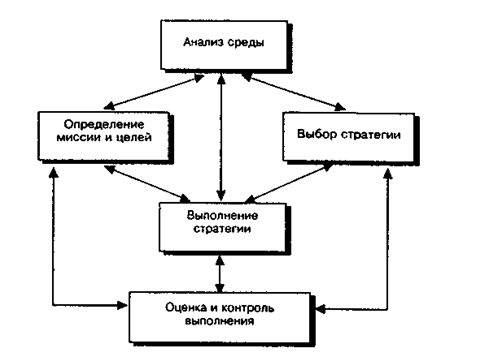home
 Management Management
 Management - Vikhanskiy OS Management - Vikhanskiy OS
|
Management - Vikhanskiy OS
1.2. System of strategic management
Strategic management can be considered as a dynamic aggregate of five interrelated management processes. These processes logically follow (or follow) one another. However, there is a stable feedback and, accordingly, the inverse effect of each process on the rest and on their entirety. This is an important feature of the strategic management system. Schematically, the structure of strategic management is shown in Fig. 3.1.
Environment analysis is usually considered the initial process of strategic management, as it provides a basis for determining the mission and objectives of the firm and for developing behavior strategies that enable the firm to fulfill its mission and achieve its goals. Analysis of the environment involves the study of its three parts: 1) macroenvironment; 2) the immediate environment; 3) the internal environment.

Figure 3 1 Structure of Strategic Management
The analysis of the macroenvironment includes studying the influence of such components of the environment as: the state of the economy; Legal regulation and management; Political processes; Natural environment and resources; Social and cultural components of society; Scientific and technical development of the society; Infrastructure, etc.
The immediate environment is analyzed for the following main components: buyers; Suppliers; Competitors; Labor market.
Analysis of the internal environment reveals those internal opportunities and the potential that a firm can expect to compete in the process of achieving its goals, and also allows more correctly formulate a mission and better understand the goals of the organization. It is extremely important to always remember that the organization not only produces products for the environment, but also provides an opportunity for its members to exist, giving them work, the opportunity to participate in profits, creating social conditions for them, etc.
The internal environment is analyzed in the following areas:
• personnel of the firm, their potential, qualifications, interests, etc .;
• organization of management;
• production, including organizational, operational and technical and technological characteristics, research and development;
• company finance;
• marketing;
• organizational culture.
The definition of mission and objectives, considered as one of the processes of strategic management, consists of three subprocesses, each of which requires a large and exceptionally responsible work. The first sub-process is to determine the mission of the firm, which in concentrated form expresses the meaning of the existence of the firm, its purpose. Next is the subprocess definition of long-term goals. This part of the strategic management of the subprocess for determining short-term goals is coming to an end. Determining the mission and objectives of the firm leads to what becomes clear why the firm functions and what it seeks. And knowing this, you can more correctly choose a strategy of behavior.
After the mission and goals are defined, the stage of analysis and choice of strategy comes. This process is rightly considered the heart of strategic management. With the help of special methods, the organization determines how it will achieve its goals and realize its mission.
Implementation of the strategy is a critical process, since it is in the event of a successful implementation that the firm leads to the attainment of the set goals. Very often there are cases when firms are not able to implement the chosen strategy. This is either because the analysis was incorrect and incorrect conclusions were drawn, or because unforeseen changes in the external environment occurred. However, the strategy is often not implemented, and because management can not properly involve the firm's existing potential for implementing the strategy. In particular, this refers to the use of labor potential.
Evaluation and monitoring of the implementation of strategies is logically the last process carried out in strategic management. This process provides a steady feedback between how the process of achieving the goals is going on, and actually the goals of the organization.
The main tasks of any control are the following: 1) determination of what and by what indicators to check; 2) assessment of the state of the controlled facility in accordance with accepted standards, standards or other benchmarks; 3) finding out the reasons for the deviations, if any, as a result of the assessment; 4) making adjustments if necessary and possible. In the case of monitoring the implementation of strategies, these tasks become quite specific, due to the fact that strategic control is aimed at finding out to what extent the implementation of strategies leads to the achievement of the objectives of the firm. This fundamentally distinguishes strategic control from management or operational control, as it is not interested in the correctness of the implementation of the strategic plan, the correct implementation of the strategy or the correct execution of individual works, functions and operations. Strategic control is focused on whether it is possible to further implement the adopted strategies and whether their implementation will lead to the achievement of the set goals. Adjustment based on the results of strategic control can affect both the company's strategies and objectives.


Comments
When commenting on, remember that the content and tone of your message can hurt the feelings of real people, show respect and tolerance to your interlocutors even if you do not share their opinion, your behavior in the conditions of freedom of expression and anonymity provided by the Internet, changes Not only virtual, but also the real world. All comments are hidden from the index, spam is controlled.